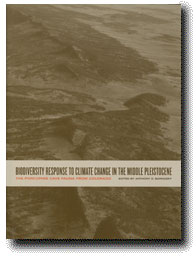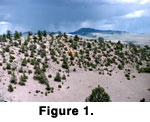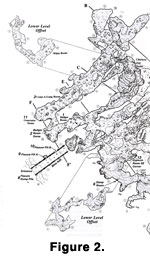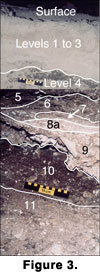Biodiversity Response to Climate Change in
the Middle Pleistocene:
The Porcupine Cave Fauna from Colorado
A.D. Barnosky, ed.
University of
California Press
Berkeley, CA. 2004. 407 pps.
ISBN: 0-520-24082-0 $135.00.
|
 |
|

One of
the most valuable contributions to ecology over the last 25 years has been
long-term ecological research (LTER) in diverse ecosystems around the world. The U.S. National Science Foundation has supported
such
research at 26 sites
in the United States and Antarctica since 1980. In 1993, the
International Long Term Ecological Network formed to support interdisciplinary
research and monitoring over the long term and large spatial scales; now 30
countries have formed LTER
programs. Long-term
ecological research has examined the dynamics of primary production, populations, nutrient cycling, and disturbances in terrestrial and aquatic
systems. Such studies have been essential for documenting the dynamics of
fundamental biophysical processes at different spatial scales, as well as the
frequency and magnitude of disturbances and responses of populations and
ecosystems.
 But
many ecological processes occur on much longer timescales than 25 or even 100
years. These processes include (1) phenomena in which the driving factor
changes over longer time periods, (2) phenomena with long response times, and
(3) their interactions. The empirical record of these phenomena exceeds the
length of most long-term ecological studies. While these systems may be
amenable to modeling, the models need testing with data, ideally from many
examples. The historical record, stretching from human history to earth
history, is critically important for documenting and analyzing ecological
processes and interactions that occur on timescales of 102 to 106
years. This is the context for the book Biodiversity Response to Climate
Change in the Middle Pleistocene: The Porcupine Cave Fauna from Colorado,
edited by Anthony D. Barnosky. Porcupine Cave (Figure 1), located in the intermontane basin of South Park, central Colorado, contains vertebrate remains
from the late Pliocene to the present time, with a detailed record of mammalian
populations and communities from an interval spanning two mid-Pleistocene
glacial-interglacial transitions. In essence, Porcupine Cave is a LTER site.
But
many ecological processes occur on much longer timescales than 25 or even 100
years. These processes include (1) phenomena in which the driving factor
changes over longer time periods, (2) phenomena with long response times, and
(3) their interactions. The empirical record of these phenomena exceeds the
length of most long-term ecological studies. While these systems may be
amenable to modeling, the models need testing with data, ideally from many
examples. The historical record, stretching from human history to earth
history, is critically important for documenting and analyzing ecological
processes and interactions that occur on timescales of 102 to 106
years. This is the context for the book Biodiversity Response to Climate
Change in the Middle Pleistocene: The Porcupine Cave Fauna from Colorado,
edited by Anthony D. Barnosky. Porcupine Cave (Figure 1), located in the intermontane basin of South Park, central Colorado, contains vertebrate remains
from the late Pliocene to the present time, with a detailed record of mammalian
populations and communities from an interval spanning two mid-Pleistocene
glacial-interglacial transitions. In essence, Porcupine Cave is a LTER site.
The
particular ecological relevance of Porcupine Cave is its record of faunal
response to climatic changes during the transitions from glacial to interglacial
conditions. According to Barnosky, the “faunal dynamics that characterize
Porcupine Cave climatic transitions probably typify how ecosystems respond to
climatic warming episodes at the high end of ‘natural’ warming rates” (p. 5).
Such records establish a “baseline” in biodiversity and ecosystem processes; we
need to understand the baseline in order to recognize when changes in diversity
will lead to catastrophic shifts in ecosystem processes. Barnosky frames the
relevance of the book in terms of the effects of current global warming on
biodiversity and ecosystem processes.
The
book has the nature of a monograph, with 26 chapters separately authored; but
with over 20,000 fossils identified thus far and various systematic and paleoecological issues still in progress, it is clearly not the last word on the
cave or its faunas. The book is divided into three sections—(1) the geology and
environmental context of the cave and taphonomy of fossil assemblages, (2)
systematic accounts of the vertebrate faunas, and (3) analysis of mammalian
faunal change in relation to environmental change. Excavation started in 1985
in Porcupine Cave and the book synthesizes 15 years of fieldwork by crews from
the Carnegie Museum of Natural History, the Denver Museum of Nature and Science,
and the University of California Museum of Paleontology in Berkeley.
In
Part 1 (The discovery and distribution of fossils, nine chapters), we learn that
the cave sits in an Ordovician dolomite, which developed a karstic surface
before burial by Ordovician sandstone. The ancient fissures predisposed the
dolomite toward cave formation once these strata were uplifted and neared the
surface. Inside the cave, both waterlain sediments and aggradation of rocky
debris contain Plio-Pleistocene fossils. But the main agents of accumulation
were mammals and birds. The most important contributors were woodrats (Neotoma),
which collected myriad organic remains in their middens over a period of
possibly two million years, based on dated materials in the cave. Among their
retrievals were numerous raptor pellets and carnivore scats filled with bones of
small vertebrates. Second in importance were various mammalian carnivores,
including coyotes, bears, and badgers, that used the cave as a den. In
addition, the cave may have been a natural trap from time to time, although
relatively few skeletons of larger mammals are preserved.
 The
cave contains 26 distinct fossil localities throughout its serpentine passages
(Figure 2); each locality represents hundreds to thousands of years of
accumulation. Most faunal information comes from seven localities, including
several that received detailed excavation. Dating has been accomplished mainly
by biostratigraphy. Among the cave localities, correlation is based on first and
last appearances of key mammalian taxa, on co-occurrences of taxa, and on
relative-abundance of several arvicolines (voles and lemmings). Arvicolines also
provide correlation to the absolute timescale and to global oxygen-isotope
stages. Magnetostratigraphy of the Pit, one of the better-studied localities
with stratified sediments (Figure 3), revealed three reversals within 1 meter of
sediment! These are interpreted as the Brunhes/Matuyama boundary and the
Jaramillo Event. One chapter describes the modern ecology of South Park in
terms of climate, bedrock geology and its relation to vegetation assemblages,
and fauna; this information is a point of reference for many of the paleoecological inferences for the middle Pleistocene fossil assemblages. Another chapter reviews the human history of the region from the Native
Americans to modern occupants.
The
cave contains 26 distinct fossil localities throughout its serpentine passages
(Figure 2); each locality represents hundreds to thousands of years of
accumulation. Most faunal information comes from seven localities, including
several that received detailed excavation. Dating has been accomplished mainly
by biostratigraphy. Among the cave localities, correlation is based on first and
last appearances of key mammalian taxa, on co-occurrences of taxa, and on
relative-abundance of several arvicolines (voles and lemmings). Arvicolines also
provide correlation to the absolute timescale and to global oxygen-isotope
stages. Magnetostratigraphy of the Pit, one of the better-studied localities
with stratified sediments (Figure 3), revealed three reversals within 1 meter of
sediment! These are interpreted as the Brunhes/Matuyama boundary and the
Jaramillo Event. One chapter describes the modern ecology of South Park in
terms of climate, bedrock geology and its relation to vegetation assemblages,
and fauna; this information is a point of reference for many of the paleoecological inferences for the middle Pleistocene fossil assemblages. Another chapter reviews the human history of the region from the Native
Americans to modern occupants.
 A chapter about woodrat biology documents the
impressive taxonomic diversity of remains collected by the four species of
Neotoma living in Colorado today. The final chapter on taphonomic
modification and paleopathology of mammal bones illustrates (with high-quality
photos and drawings) a range of bone-damage patterns reflecting carnivore behaviors,
rodent gnawing, digestion, as well as disease in the living animals. This
section of the book would have benefited from a more comprehensive taphonomic analysis of the fossil assemblages, particularly with reference to
the extensive literature about woodrat middens.
A chapter about woodrat biology documents the
impressive taxonomic diversity of remains collected by the four species of
Neotoma living in Colorado today. The final chapter on taphonomic
modification and paleopathology of mammal bones illustrates (with high-quality
photos and drawings) a range of bone-damage patterns reflecting carnivore behaviors,
rodent gnawing, digestion, as well as disease in the living animals. This
section of the book would have benefited from a more comprehensive taphonomic analysis of the fossil assemblages, particularly with reference to
the extensive literature about woodrat middens.
Part 2
(Systematic accounts of taxa, 12 chapters) documents the faunal diversity that
makes Porcupine Cave such an important middle Pleistocene site. Few chapters
illustrate key specimens; this addition would have been valuable. One chapter
mentions the presence of mollusks in some fossil assemblages, and Neotoma
middens are usually loaded with plants but these are never mentioned. The
vertebrate list is impressive—2 amphibians, 4 reptiles, 45 birds, and 73 mammals
recognized from the 20,000 fossils identified thus far. Most fossils are middle
Pleistocene in age (Irvingtonian North American Land Mammal Age), especially
between 600 Ka to 1 Ma, but some are clearly lower Pleistocene or older (Blancan
North American Land Mammal Age). Twenty-eight species (20 birds, 8 mammals)
first occur in North America in these localities. At least seven mammals found
in Porcupine Cave are now extinct. Chapter 10 provides faunal lists for all the
fossil localities, as well as estimates of the number of specimens and
individuals for the better-studied assemblages. The other chapters describe the
status of taxonomic groups. Specimen numbers assigned to taxa are listed within
the chapter (if the group is rare) or in an appendix. The cave records
salamanders, toads, lizards, and several kinds of snakes—a more diverse
herpetofauna than currently inhabits South Park. Even though birds are known
from only about 200 identified specimens, 45 taxa are recognized. These range
in size from various sparrows to a great horned owl; the most numerous species
is the sage grouse. Mammalian carnivores are represented by 23 species. The
most common species are coyotes, badgers, and spotted skunks. Rarer taxa
include the now-extinct North American cheetah. Ochotonids (pikas) are
moderately common and may represent the first documented pikas from the Blancan
of North America. Leporids (rabbits and hares) are represented by as many as 10
species from a small set of localities in the Velvet Room of Porcupine Cave; as
many as eight species were contemporaneous. No wonder there were so many
coyotes.
Rodents are by far the most numerous mammalian fossils. The presence of
geomyoids (kangaroo rats and pocket gophers), of murids (Peromyscus in
particular), and porcupines is noted. Squirrels, Neotoma, and arvicolines
each get an entire chapter. In the sciurid chapter, 11 taxa are described,
mostly ground squirrels. Tamiasciurus hudsonicus is the only obligate
tree squirrel. This chapter contains a biochronologic scheme based on species
of Spermophilus and Cynomys; this scheme relies on the presence or
absence of rare taxa for some levels, and no stratigraphic range diagram is
given, so the utility of this scheme is difficult to assess. Variation over
time in dental measurements signifies microevolution in the cheek teeth of two taxa. Many of the squirrel taxa live in the vicinity of Porcupine Cave today. Not so
for species of Neotoma. This chapter's author, Repenning, recognizes five species, all extant taxa. Most of them do not live in South Park today but occur at lower
elevations in Colorado. Porcupine Cave is the earliest record for all five
species. Four occur in “great plains” habitats today; only N. cinerea,
the bushy-tailed woodrat, lives in South Park. To explain the presence of
great-plains taxa at such a high elevation in the middle Pleistocene, Repenning
contrasts climatic change with tectonic uplift as explanatory hypotheses. No
firm conclusion is reached but he provides plausible evidence for the tectonic
hypothesis. Arvicolines are the most numerous mammals in the fauna. I did not
find a tally of the total number of identified specimens, but the appendix for
this chapter is 44 pages long! A minimum of 13 lineages is recognized, with as
many as nine occurring in the same stratigraphic unit. Only four of these taxa
are extant. Compared to other high-elevation fossil localities of Plio-Pleistocene
age, Porcupine Cave shows significant differences in arvicolines—a pattern of
geographic heterogeneity in montane faunas that also occurs today.
The
last two faunal chapters, both well illustrated, cover ungulates. Equids are
represented by 56 mostly fragmentary specimens. Nonetheless, four taxa are
recognized—an ass, a hemionine, and one large and one small caballine. A similar
number of fossils, most <20 cm long, are the basis for identifying 12
artiodactyls—a peccary, two camels, four deer, two pronghorns, one bighorn
sheep, one mountain goat, and one muskox. The rare and fragmentary nature of
the fossils make it unlikely that the artiodactyls were ever cave occupants;
more likely, their isolated bones were brought in by other animals or washed
into fissures. For two of the tables in this chapter, the anatomical
abbreviations are undefined, making it hard to appreciate the significance of
the measurements.
Part 3
(Effect of environmental change on the Porcupine Cave fauna, 5 chapters)
documents faunal changes and their paleoenvironmental context. A detailed faunal
analysis of the Badger Room locality includes construction of the climate space
for temperature and precipitation for extant taxa considered ecologically
equivalent to two rodents that are abundant in the fossil assemblage.
Reconstructed temperature and precipitation patterns over the year indicate
slightly longer, wetter, and possibly cooler winters than those of today. Also,
the trophic and size structure of the 42 mammalian species of the Badger Room fauna is
compared with the structure of the modern fauna. Faunal structure and richness
are quite similar, despite about 40% turnover of taxa since the middle
Pleistocene. Curiously, despite the detailed paleoenvironmental reconstructions,
the authors never say whether the fauna represents a glacial or an interglacial
interval.
 The
chapter about faunal dynamics of the Pit documents quantitative changes in
rodent taxa in relation to the record of climate change inferred on the basis of
sediments. Sedimentary features of 14 strata indicate an alternation between
glacial and interglacial intervals spanning 780 to at least 900 ka. The faunal
analysis is based on almost 7000 identified fossils representing 1402
individuals. A rarefaction analysis indicates that samples from different
stratigraphic units have similar structure; samples with >500 specimens gain few
new species with increased sample size. The relative abundance of the original taxa in the
fossil assemblage is considered to be a good representation of the relative
abundance of populations because of the propensity of woodrats to collect
remains in proportion to their availability. The substantial sample sizes of
rodents and leporids are the basis for a series of small-mammal “pollen”
diagrams (e.g., Figure 4), in which changes in relative abundance over time are
used as the basis for paleoenvironmental reconstruction. The arvicoline pollen
diagram (Figure 4) is the basis for especially detailed inferences, largely
from variation in the frequencies of Mictomys sp., the bog lemming, and
Lemmiscus curtatus, the sagebrush vole—species whose modern ranges do not
overlap. This fascinating chapter needs a more explicit analysis of when
appearances and disappearances could have plausibly resulted from elevational shifts in
species ranges versus regional appearances and disappearances. Also, some
circular reasoning creeps in: changes in rodent frequencies are used to infer
changes in vegetation and climatic conditions, which are then viewed as the cause
of changes in rodent frequencies over time.
The
chapter about faunal dynamics of the Pit documents quantitative changes in
rodent taxa in relation to the record of climate change inferred on the basis of
sediments. Sedimentary features of 14 strata indicate an alternation between
glacial and interglacial intervals spanning 780 to at least 900 ka. The faunal
analysis is based on almost 7000 identified fossils representing 1402
individuals. A rarefaction analysis indicates that samples from different
stratigraphic units have similar structure; samples with >500 specimens gain few
new species with increased sample size. The relative abundance of the original taxa in the
fossil assemblage is considered to be a good representation of the relative
abundance of populations because of the propensity of woodrats to collect
remains in proportion to their availability. The substantial sample sizes of
rodents and leporids are the basis for a series of small-mammal “pollen”
diagrams (e.g., Figure 4), in which changes in relative abundance over time are
used as the basis for paleoenvironmental reconstruction. The arvicoline pollen
diagram (Figure 4) is the basis for especially detailed inferences, largely
from variation in the frequencies of Mictomys sp., the bog lemming, and
Lemmiscus curtatus, the sagebrush vole—species whose modern ranges do not
overlap. This fascinating chapter needs a more explicit analysis of when
appearances and disappearances could have plausibly resulted from elevational shifts in
species ranges versus regional appearances and disappearances. Also, some
circular reasoning creeps in: changes in rodent frequencies are used to infer
changes in vegetation and climatic conditions, which are then viewed as the cause
of changes in rodent frequencies over time.
Marmot
tooth enamel was sampled for stable isotopes of oxygen and carbon form levels
1-7 of the Pit (spanning interglacial-glacial-interglacial sediments). Whereas
no significant changes in
 18O
values occurred over time, the
18O
values occurred over time, the
 13C
samples became more negative from older to younger levels. All
13C
samples became more negative from older to younger levels. All
 13C
values are within the C3 region of the carbon spectrum (<-8.0‰). The significance of this shift is not entirely clear, and it would be useful to
know how
13C
values are within the C3 region of the carbon spectrum (<-8.0‰). The significance of this shift is not entirely clear, and it would be useful to
know how
 13C
values in vegetation change along elevational gradients today.
13C
values in vegetation change along elevational gradients today.
The
penultimate chapter is an analysis of dental variables in Marmota
populations from the Pit. In light of the life-history of marmot populations
living at high elevations, the authors generate expectations about dental traits
that should be under selective pressure related to climatic change and other
traits that should be selectively neutral in relation to climatic change.
Analysis of changes over time in the mean and frequency distributions of dental
variables shows no statistically significant changes in the traits hypothesized
to change in relation to climate. The authors conclude that the climatic
variations of this middle Pleistocene interval did not perturb marmot evolution;
rather marmot populations have been stable and persistent to the present day.
The
final chapter by Barnosky summarizes changes in lineages and faunas in light of
the overarching question—how does climatic change affect terrestrial
biodiversity? Barnosky summarizes changes in mammalian populations, in species
richness, and in faunal structure over the middle Pleistocene sequence of
glacial and interglacial intervals. Although notable changes did occur,
particularly during the youngest transition from a glacial to an especially
warm, dry interglacial, the climatic changes of these glacial cycles did not
substantially disrupt mammalian lineages or faunal structure. The record at
Porcupine Cave suggests that ecosystems are resilient to climatic changes of
the magnitude of glacial to interglacial transitions, even as a moderate level
of taxonomic turnover is ongoing. Species with specialized requirements (Mictomys,
Lemmiscus in this sequence) showed greater fluctuations in abundance over
time than species with general requirements. Greater turnover occurred among
rare species than among common species. Lessons for the future involve
generalization of the pattern from Porcupine Cave: climatic change of the rates
and magnitudes of Quaternary glacial and interglacial cycles will affect
population densities and geographic ranges, but will not alter ecosystem
structure. Part of this resilience is maintained by genetic diversity among
populations across the landscape level, open dispersal corridors, and the
presence of many ecologically equivalent species at the regional level—in other
words, metapopulations and metacommunities. The circumstances facing the 21st
century are different, however. Global warming is predicted to exceed normal
glacial-interglacial variation, many populations and species are already
vulnerable to human activities, and dispersal is restricted by human
modifications of the landscape. Barnosky concludes with an appeal to keep
ecologically similar areas as connected as possible to allow natural migration
and dispersal; to minimize anthropogenic global warming; and to maintain the
functional integrity of ecosystems even if species composition changes.
The
strengths of this book greatly outweigh its weaknesses. The strengths include
the clear organization, the substance and quality of the contributions, and the
scope of geological and paleontological documentation. Even though this book
represents a progress report rather than a final summary, it convinces us that
Porcupine Cave is “arguably the richest source of information in the world on
Irvingtonian-age vertebrates” (p. 6). Linking the faunal analysis from the
middle Pleistocene sequence of glacial cycles to effects of modern climatic
change on biodiversity highlights the importance of the Quaternary record as a
critical bridge between modern ecological research and paleoecology of Neogene
and older records, where temporal and taxonomic resolution are usually lower. The main weaknesses of this volume are the absence of information about
vegetation and the lack of illustrations for many of the systematic accounts. With such large sample sizes, the faunal data are ripe for a more quantitative
treatment but that can come in later publications. Overall, this book is a fine
achievement. I strongly recommend it for paleontologists and for neontologists concerned about the
current mass extinction.




